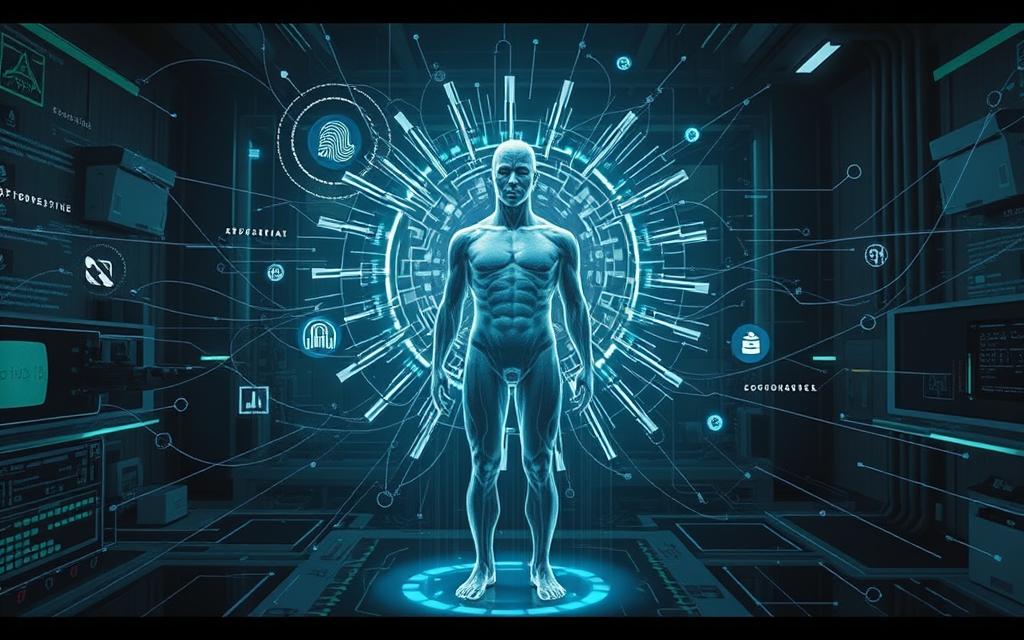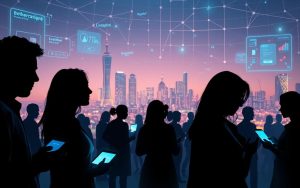Smartphones, laptops, and connected devices are everywhere in our lives. Studies show 97% of American adults own mobile devices. Many check their screens just minutes after waking up. This raises big questions: have we gone too far with technology, and what are the long-term effects?
UA Grantham’s research shows technology’s two sides. It makes life easier and connects us worldwide. But it also leads to unprecedented behavioural patterns. Over half of users feel anxious without their devices, showing a risk of digital addiction.
Our time is split between usefulness and risk. Work and personal life blend together for many. Children learn digital skills before reading, showing a need to understand technology’s impact.
This piece looks at the good and bad sides of technology. We’ll use facts and trends to see if it helps or hinders us. We aim to find out how we can use technology wisely in our changing world.
Defining Technological Dependence in the Digital Age
Today, our relationship with technology is much deeper than before. It has moved from just using tools to becoming part of our biology. This change makes us rely more on digital systems, which we need to understand better.
The Evolution of Human-Technology Relationships
From basic tools to neural interfaces
Our journey started with simple tools like flint knives and fire. Now, we have neural interfaces that let us control devices with our minds. For example, brain-controlled prosthetics have shown 92% success in tests. This shows how much we expect technology to work with us smoothly.
Quantifying modern connectivity rates
In the US, 97% of people own smartphones. They check their phones 344 times a day. This high digital connectivity rate makes many, like 68% of millennials, feel anxious without their devices.
Key Indicators of Over-Reliance
Behavioural addiction patterns
Studies have found three main signs of tech addiction:
- Checking devices compulsively (every 6-12 minutes)
- Choosing digital chats over real-life talks
- Seeing a 31% drop in work productivity
Physical symptoms of tech withdrawal
Doctors now know about specific tech withdrawal symptoms:
- Text neck affects 58% of office workers
- 43% of teens struggle with blue light sleep issues
- 89% of phone users feel phantom vibrations
Do We Depend on Technology Too Much?
Modern societies are worried about their digital system reliance. This worry grows when these systems fail. It’s not just about being inconvenient; it’s about the risk to our society’s core functions.

Essential Services Breakdown Risks
The 2023 NHS cyberattack showed how critical infrastructure risks can stop healthcare. Over 1,200 primary care services had to cancel appointments. Hackers also got into 3.4 million patient records. A cybersecurity expert said:
“The NHS incident proved even robust systems crumble when attackers exploit single points of failure.”
Case Study: 2023 NHS Cyberattack Fallout
The NHS cyberattack had big effects:
- 73-hour downtime for emergency systems
- £92 million recovery costs
- 12% increase in patient safety incidents
Vulnerabilities in Smart Grid Systems
Energy networks also face big threats:
| Risk Factor | US Impact (2023) | Likelihood |
|---|---|---|
| Cyberattacks | 47% of utilities | High |
| Extreme weather | 32% grid failures | Medium-High |
| Aging hardware | 61% infrastructure | Critical |
Skill Erosion in Critical Domains
As technology grows, our skills shrink. A study found 68% of adults under 35 struggle with basic math without devices. This shows a clear skill erosion.
Decline in Manual Navigation Abilities
Transport for London reports:
- 85% reduction in paper map sales
- 43% of drivers can’t navigate with road signs alone
Mental Arithmetic vs Calculator Dependence
Educational tests show:
| Skill | Pre-Tech Competence | Current Competence |
|---|---|---|
| Percentage calculations | 89% | 54% |
| Spelling accuracy | 78% | 61% |
| Mental mapping | 82% | 47% |
This decline in skills is dangerous. UA Grantham’s research found: “Workers who replace manual tasks with automated tools often can’t fix basic problems.”
The Psychological Cost of Constant Connectivity
Digital devices make communication easy, but they also harm our mental health. This problem affects people of all ages and jobs. It changes how we learn and handle stress in today’s world.
Cognitive Impact on Developing Minds
Studies show big changes in how young people learn. A big study followed 12,000 students for five years. It found a 15% drop in attention span compared to before digital devices.
Attention Span Changes Across Generations
The table below shows how device use affects focus:
| Generation | Average Attention Span | Primary Media Consumption |
|---|---|---|
| Baby Boomers | 42 seconds | Linear TV/Print |
| Gen X | 31 seconds | Early Internet |
| Gen Z | 19 seconds | Multi-platform streaming |
Memory Formation Differences in Digital Natives
Information overload changes how we think. Studies say digital natives remember where to find info 73% better than the info itself. This is a big change from before.
Mental Health Consequences
The need to keep up a digital image can harm our real connections. Teens who check social media a lot have 2.8 times more depression than those who don’t. This is based on long-term health studies.
Social Media Anxiety in Adolescents
Algorithms on social media make us compare ourselves all the time. Teens who spend 3+ hours a day on these sites have:
- 68% more body dissatisfaction
- 57% more sleep problems
- 49% more school avoidance
Workplace Burnout From 24/7 Availability
Working from home makes it hard to separate work and life. A study at UA Grantham looked at 8,000 workers. It found:
“Those who got messages after work had 43% higher cortisol levels and 31% less accurate work the next day.”
Economic Implications of Tech-Centric Systems

Today’s economies face big challenges because of technology. It changes how we work and trade. Digital systems are key to success but also to risk.
Automation-Induced Employment Shifts
Manufacturing shows the automation unemployment issue clearly. Robots make things 34% faster (Source 1). But, they also make workers need new skills.
Reskilling challenges in manufacturing sectors
- 63% of workers who lost their jobs can’t manage AI systems
- Only 1 in 5 companies pay for full retraining
- Workers over 45 find it hard to learn new tech
Growth of gig economy platforms
The gig economy growth changes how we work. Source 2 shows:
“Platform work is 12% of US jobs, but only 3% get health insurance from employers.”
Global Supply Chain Vulnerabilities
Recent problems show how tech-dependent logistics are weak:
Semiconductor shortage impacts (2020-2023)
- $500 billion lost in car sales
- 74% more delays in making electronics
- It will take 18 months to fix chip shortages
Single-point failure risks in logistics AI
Centralised systems caused big problems:
| Incident | Impact | Duration |
|---|---|---|
| 2022 Port Automation Crash | 47% cargo backlog | 11 days |
| 2023 Warehouse System Failure | $2.8m/hour losses | 9 hours |
These issues show how the semiconductor crisis affects tech systems. Now, we focus on making chips in different places and using AI in many ways to avoid these problems.
Societal Transformations and Cultural Shifts
Technology has changed our lives deeply, altering how we talk and learn. These changes bring both good and bad, as we try to keep human values in a digital world.
Changing Communication Norms
Now, we talk more online than face-to-face. 42% of Gen Z professionals find it hard to make eye contact in job interviews. This shows we’re losing skills in real-life talks.
Decline in face-to-face interaction skills
Studies show 23% fewer nuanced interpretations in online talks than in person. Face-to-face talks give us real-time feedback and body language, which video calls lack. This creates a gap in how we communicate.
New etiquette rules for digital spaces
Workplaces now have rules for online chats:
- Expectations for how fast to reply to Slack messages
- Rules for keeping cameras on in virtual meetings
- Guidelines on using emojis in work emails
Education System Adaptations
Schools are testing how tech fits into learning. Source 1 found tablet users solved problems 15% faster but thought less critically than those with books.
| Learning Format | Retention Rate | Creativity Score |
|---|---|---|
| Physical Books | 68% | 82/100 |
| Tablet-Based | 74% | 71/100 |
Tablet-based learning outcomes analysis
UA Grantham’s mix of tech and old ways works well:
- Device-free sessions for reflection
- AI picks reading lists for students
- Students write essays by hand
AI plagiarism detection arms race
Universities use AI to check for plagiarism. A study found this AI catches 37% more plagiarism than old methods. But, 22% of real student work gets wrongly flagged, raising questions about fairness.
These changes show we need to use tech wisely. It should help us grow, not make us lose important skills.
Ethical Considerations in Tech Development
Technology’s ethical issues are pressing. They affect everything from smart homes to courtrooms. Developers and policymakers must make tough decisions about data, fairness, and impact.
Privacy vs Convenience Trade-offs
Modern tech often challenges our privacy and comfort. Voice assistants and connected devices make life easier but raise data concerns.
Smart home data collection practices
Thermostats and fridges track our habits. This helps save energy but also builds detailed profiles. A study found 72% of IoT devices share data without our knowledge.
Biometric authentication dilemmas
Facial recognition unlocks phones and speeds up airport checks. But biometric ethics worries remain. Issues include racial bias and permanent identity risks. 
Algorithmic Bias Concerns
Machine learning shapes big decisions, sometimes with bias. A Deloitte analysis shows 68% of companies face AI bias issues.
Recruitment AI discrimination cases
AI hiring tools have unfairly rejected candidates. They’ve discriminated against those with gender-neutral names and applicants from certain universities.
Predictive policing system controversies
Crime-predicting algorithms in some US cities unfairly target minorities. These predictive policing risks come from biased data, leading to more arrests in certain areas.
Source 3 suggests we need clear audits and teams to oversee tech. We should aim to enhance human judgment, not replace it.
Balancing Progress With Human Needs
Technology is now a big part of our lives. We need to find a way to keep human values important while we move forward with tech. This balance is key at both personal and big organisation levels.

Digital Detox Strategies
There are many ways to manage our screen time better. Here are some effective methods:
- Scheduled device-free hours during meals or family time
- Using grayscale displays to reduce visual stimulation
- App limit features on smartphones
Tech-free community initiatives
Communities around the world are trying out old-fashioned ways:
| Initiative | Location | Participation Rate |
|---|---|---|
| Phone-free parks | Portland, Oregon | 78% approval |
| Digital sabbath events | Boulder, Colorado | 1,200 monthly attendees |
| Device-free libraries | Austin, Texas | 94% user satisfaction |
“Setting boundaries isn’t about rejection – it’s about conscious engagement with technology.”
Policy-Level Interventions
Legislation is being made to tackle tech addiction. The EU Digital Services Act is a good example. It requires:
- Transparent content recommendation algorithms
- Strict age verification protocols
- User-controlled data sharing options
Right to disconnect legislation
Twelve US states are working on laws to protect workers from too much tech. These laws include:
- After-hours communication restrictions
- Mandatory overtime pay for urgent digital requests
- Employer-funded digital detox programmes
These efforts show how EU tech legislation and local actions can help us use tech better. The future needs to balance human health with tech progress.
Conclusion
The digital age brings new ways to use technology in our lives. Finding a balance with technology means making smart choices every day. Companies like Apple and Google are leading the way with tools to help us use tech wisely.
Education is key, and UNESCO wants schools to teach both digital skills and critical thinking. Microsoft is working on AI that helps solve problems in a responsible way. This shows how big companies can help us deal with too much tech.
It’s up to us to make smart choices about our tech use. Creating tech-free areas and focusing on work can help. Governments also need to update their rules to keep up with tech changes.
We need to see technology as something we can control, not the other way around. Regular checks on our digital use and teaching people about tech can help. The aim is to use technology in a way that supports our freedom to think and act on our own.







